Evidence of selection for an accessible nucleosomal array in human
- PMID: 27472913
- PMCID: PMC4966569
- DOI: 10.1186/s12864-016-2880-2
Evidence of selection for an accessible nucleosomal array in human
Abstract
Background: Recently, a physical model of nucleosome formation based on sequence-dependent bending properties of the DNA double-helix has been used to reveal some enrichment of nucleosome-inhibiting energy barriers (NIEBs) nearby ubiquitous human "master" replication origins. Here we use this model to predict the existence of about 1.6 millions NIEBs over the 22 human autosomes.
Results: We show that these high energy barriers of mean size 153 bp correspond to nucleosome-depleted regions (NDRs) in vitro, as expected, but also in vivo. On either side of these NIEBs, we observe, in vivo and in vitro, a similar compacted nucleosome ordering, suggesting an absence of chromatin remodeling. This nucleosomal ordering strongly correlates with oscillations of the GC content as well as with the interspecies and intraspecies mutation profiles along these regions. Comparison of these divergence rates reveals the existence of both positive and negative selections linked to nucleosome positioning around these intrinsic NDRs. Overall, these NIEBs and neighboring nucleosomes cover 37.5 % of the human genome where nucleosome occupancy is stably encoded in the DNA sequence. These 1 kb-sized regions of intrinsic nucleosome positioning are equally found in GC-rich and GC-poor isochores, in early and late replicating regions, in intergenic and genic regions but not at gene promoters.
Conclusion: The source of selection pressure on the NIEBs has yet to be resolved in future work. One possible scenario is that these widely distributed chromatin patterns have been selected in human to impair the condensation of the nucleosomal array into the 30 nm chromatin fiber, so as to facilitate the epigenetic regulation of nuclear functions in a cell-type-specific manner.
Keywords: GC content; Human genome; Mutation rates; Nucleosome depleted regions; Nucleosome ordering; Sequence evolution.
Figures

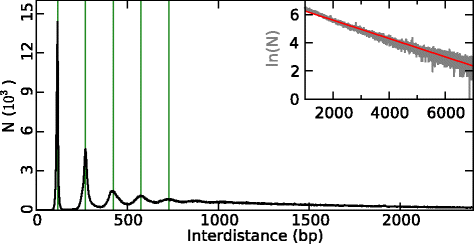
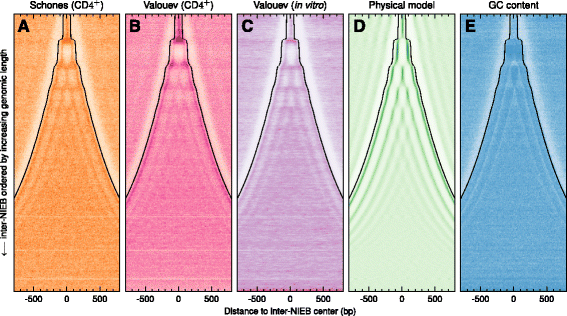
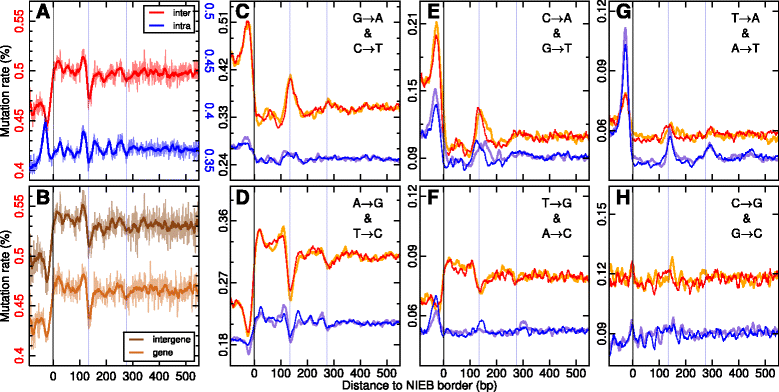
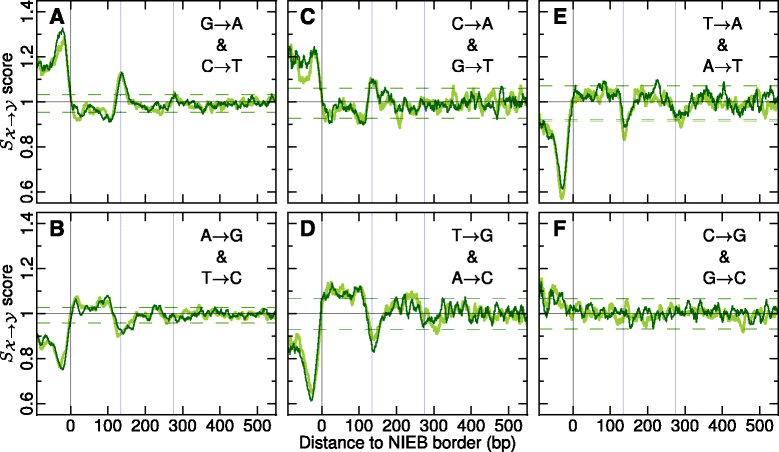
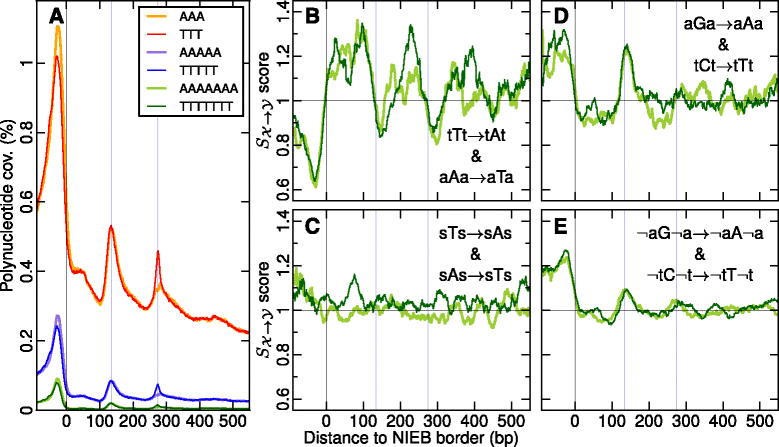
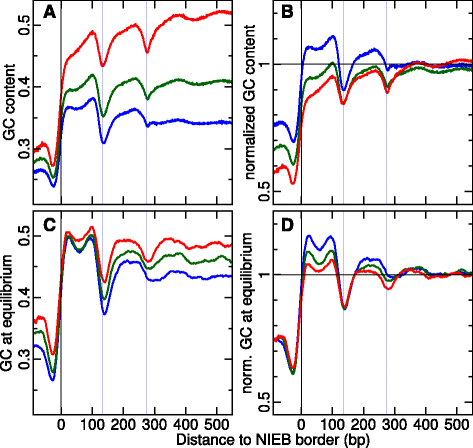
Similar articles
-
Evidence for DNA Sequence Encoding of an Accessible Nucleosomal Array across Vertebrates.Biophys J. 2018 May 22;114(10):2308-2316. doi: 10.1016/j.bpj.2018.02.025. Epub 2018 Mar 24. Biophys J. 2018. PMID: 29580552 Free PMC article.
-
Ubiquitous human 'master' origins of replication are encoded in the DNA sequence via a local enrichment in nucleosome excluding energy barriers.J Phys Condens Matter. 2015 Feb 18;27(6):064102. doi: 10.1088/0953-8984/27/6/064102. Epub 2015 Jan 7. J Phys Condens Matter. 2015. PMID: 25563930
-
Widespread signatures of recent selection linked to nucleosome positioning in the human lineage.Genome Res. 2011 Nov;21(11):1777-87. doi: 10.1101/gr.122275.111. Epub 2011 Sep 8. Genome Res. 2011. PMID: 21903742 Free PMC article.
-
Nucleosome positioning in yeasts: methods, maps, and mechanisms.Chromosoma. 2015 Jun;124(2):131-51. doi: 10.1007/s00412-014-0501-x. Epub 2014 Dec 23. Chromosoma. 2015. PMID: 25529773 Review.
-
Coupling between Sequence-Mediated Nucleosome Organization and Genome Evolution.Genes (Basel). 2021 Jun 1;12(6):851. doi: 10.3390/genes12060851. Genes (Basel). 2021. PMID: 34205881 Free PMC article. Review.
Cited by
-
DNA sequence-dependent chromatin architecture and nuclear hubs formation.Sci Rep. 2019 Oct 10;9(1):14646. doi: 10.1038/s41598-019-51036-9. Sci Rep. 2019. PMID: 31601866 Free PMC article.
-
Evidence for DNA Sequence Encoding of an Accessible Nucleosomal Array across Vertebrates.Biophys J. 2018 May 22;114(10):2308-2316. doi: 10.1016/j.bpj.2018.02.025. Epub 2018 Mar 24. Biophys J. 2018. PMID: 29580552 Free PMC article.
-
The role of DNA sequence in nucleosome breathing.Eur Phys J E Soft Matter. 2017 Nov 30;40(11):106. doi: 10.1140/epje/i2017-11596-2. Eur Phys J E Soft Matter. 2017. PMID: 29185124 Free PMC article.
-
Multiplexing mechanical and translational cues on genes.Biophys J. 2022 Nov 15;121(22):4311-4324. doi: 10.1016/j.bpj.2022.10.011. Epub 2022 Oct 13. Biophys J. 2022. PMID: 36230003 Free PMC article.
-
Nucleosomal signatures impose nucleosome positioning in coding and noncoding sequences in the genome.Genome Res. 2016 Nov;26(11):1532-1543. doi: 10.1101/gr.207241.116. Epub 2016 Sep 23. Genome Res. 2016. PMID: 27662899 Free PMC article.
References
-
- Arneodo A, Vaillant C, Audit B, Argoul F, d’Aubenton-Carafa Y, Thermes C. Multi-scale coding of genomic information: From DNA sequence to genome structure and function. Phys Rep. 2011;498:45–188. doi: 10.1016/j.physrep.2010.10.001. - DOI
-
- Alberts B, Bray D, Lewis J, Raff M, Roberts K, Watson JD. Molecular Biology of the Cell. New-York: Garland Publishing; 2002.
-
- Graur D, Li WH. Fundamentals of Molecular Evolution. Sunderland: Sinauer Associates; 1999.
Publication types
MeSH terms
Substances
LinkOut - more resources
Full Text Sources
Other Literature Sources
Miscellaneous

